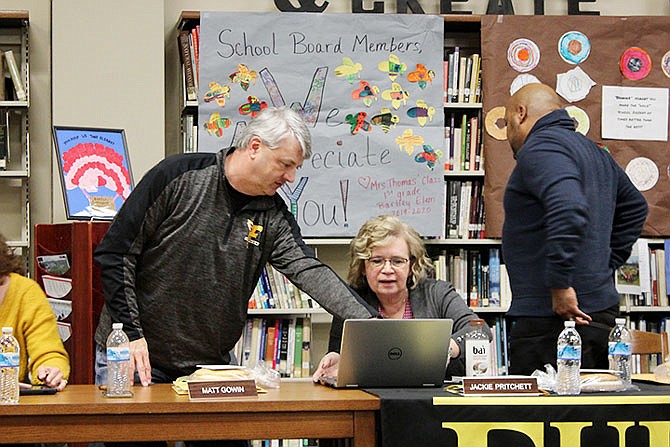The Fulton Public Schools Board of Education discussed finances and approved a plan to add three preschool classrooms at its February meeting.
The district currently has several early childhood education programs, including the Fulton Early Childhood Center preschool, the Early Intervention program and the Early Childhood Special Education program.
The FECC preschool serves 20 students in one full-day class.
"In the future, we would love to see if we could actually keep (FECC preschool) all the same, but possibly go down to 15 students, just because 20 4-year-olds is a lot of 4-year-olds," FECC Director Jennifer Meyerhoff said.
The early intervention program currently serves 40 students in half-day classes, but Meyerhoff asked the board to consider switching to a full-day program serving 20 students.
Children in full-day programs get three times as much classtime and have a better grasp of letters and counting, Meyerhoff explained.
The district's ECSE program, which includes three half-day classrooms with 30-plus students each, will remain the same.
To make space for the new classrooms, the FECC will re-purpose a staff room and space that will be vacated in June with the end of the Options Daycare program.
The board voted in December to end Options Daycare, which was a program open to FPS staff members, based on declining numbers and financial concerns.
Considering the new preschool classrooms and the changes to existing classrooms, the district will be able to serve at least five more students. In the future, the district would also be able to add additional students by hiring more classroom aides.
"If we have a boom like we did last year, we could fit more kids," Meyerhoff said. "If we have the numbers we had this year, we'd be just about right."
The district estimates adding the three teachers necessary to serve the new classrooms will cost $162,677, while the program will bring in $79,398 in revenue. The net cost of $83,279 is comparable to the cost of the Options Daycare program, which served fewer students. This brought up questions for board Vice President Todd Gray.
"I think we need a districtwide preschool due to the fact to help kindergarten and the staff, but my concern was we had an argument that we were operating in the hole and then they turned around and present us something that we're going to operate in the hole," Gray said.
In response, board President Emily Omohundro noted the Options Daycare program didn't serve district goals the same way the preschool classrooms will.
"When we talk about, as Dr. Cowherd mentioned, operating in the hole, we don't look at any of our other programs that way," Omohundro said. "The reason we looked at Options Daycare that way was because it was completely an independent-type program from the rest of the educational initiatives that we engage in. I understand your point, that it looks like the same cost, but in terms of service to kids, accomplishment of (Comprehensive School Improvement Plan) goals and what this board talked about whenever we were looking at the closure of that and creation of space I think we're furthering that goal."
The motion to hire three new teachers for the classrooms passed unanimously.
Budget
Shortly after, the board moved on to discuss finances and provide guidance on the fiscal year 2021 budget. In addition to the new preschool staff, the board signaled willingness to consider increases in compensation.
The board looked at several potential budget scenarios: option A included preliminary projections, option B included the additional preschool classrooms, option C included preschool and adding $500 to the base teacher salary and option D included the previous plans plus the costs of applying a full minimum wage of $12.
"The last couple of years, we've been budgeting and making decisions on teacher salaries under the focus of schedule D," Cowherd said. "What I need direction on tonight is if that past practice is good, we can come back with a salary recommendation in March."
The minimum wage plan would mean a pay increase for staff.
"Not to say our teachers are overpaid by any stretch of the imagination; we want to keep raising everybody up as we can, but when you look at the average teacher salary at the top versus what our hourly staff members are making, my opinion is those people need that minimum wage bump," said board member Matt Gowin.
Considering finances, several board members had requests for the district - board member Leah Baker suggested the district consider adding a second agriculture teacher and Gray asked they consider a $750 base salary increase.
Fulton High School Athletic Director Ryan Waters spoke on the issue of coach retention. Waters suggested the board consider increasing the coaching stipend by giving activity sponsors and coaches a .5 percent bump on the extra duty salary schedule after three years in their program with the district.
"If you look at it from a mile perspective, it would be an incentive for our coaches to stay," Waters said. "There's no coach in the country that's going to come to Fulton for our coaching stipends or our sweetener percentage that we have, but what this would do would show a level of appreciation to the coaches for continued years of service."
The initial proposal would begin counting longevity with 2019-20 as the base year. The board asked the district to run the numbers on how to reward time served for coaches who have already been in the district for long periods of time.
This article was edited Feb. 18, 2020, to correct the attribution of a quote about teacher salaries to Matt Gowin.

